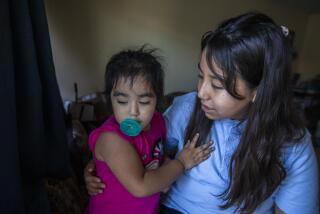Editorial: Teachers say remote learning is even less than it’s cracked up to be

- Share via
Distance learning in Los Angeles schools is definitely working better than it did last spring, but that’s hardly a ringing endorsement. Generally speaking, remote classes are still an abysmal operation in which most students lose out, and the ones with the greatest need lose most.
That assessment comes not from school administrators or researchers but from the best source of all: L.A. teachers themselves, the people who are trying to transmit skills and knowledge while giving students some sense of normality in a world gone haywire. Their sentiments are especially noteworthy considering that their labor union, United Teachers Los Angeles, has been the organization most concerned about the dangers of returning to physical classrooms.
The survey was commissioned by USC’s Rossier School of Education as well as Educators for Excellence, a teacher-led, reform-oriented organization whose financial backers include groups that teachers unions find unsympathetic, such as the Broad Foundation. But the survey of 502 teachers in both district-run and charter schools is large and well designed, so it’s fair to assume that it accurately captured the wider views among teachers. It was conducted by a well-known polling firm.
The findings make it all the more imperative that as soon as the current COVID-19 surge wanes, schools begin reopening — at least for the youngest students, who represent the lowest risk of transmitting the disease and of falling seriously ill themselves. Considering how much damage already has been done, California legislators and education officials also must plan for serious remedial work once campuses reopen, during the summer and next fall. That must include more than academic work; kids are coming out of a period of intense emotional stress and social and physical isolation. Their families’ financial stability may be shot.
According to the survey, more than 90% of teachers say that students aren’t engaged in their lessons, largely because of the environmental barriers to learning from home. Many students lack the high-speed internet they need, as well as a quiet place to do their schoolwork; they often don’t have an adult at home who can help when they’re stuck.
The teachers feel that neither they nor their most vulnerable students, such as those who are homeless or face language barriers, are getting the support or guidance they need from their schools.
One hopeful note: Only a third of the teachers thought a COVID-19 vaccine had to be widely administered before schools could reopen.
They’re right about that. Evidence from many school districts in the state, as well as from across the nation and globally, shows the same thing: Even with COVID-19 rates rising, schools that already were open have continued to conduct lessons safely on campus.
It takes boldness to be willing to reopen schools, especially when teachers and their unions object out of fear that the adults, who are more vulnerable to the disease, will be infected. Although it’s an understandable worry, it is not borne out by the experience at schools so far, at least those at the lower grade levels.
But for the most part, school districts haven’t received the kind of support they should from the federal and California governments. A new set of school-reopening guidelines by the World Health Organization lays out the responsibilities of central governments in gathering and disseminating useful data on school-reopening safety so that local school officials have solid information to go by. That hasn’t happened in the United States, and California doesn’t even have a timely and transparent method of reporting COVID-19 infections at schools. This doesn’t help anyone’s confidence.
The state also needs a plan for how this entire cohort of students can come up to speed once schools reopen. Maybe not all of them can; some might have to repeat the year. Either way, it will require plenty of money, but it’s not enough to just throw extra cash at school districts. Tony Thurmond, state superintendent of public instruction, should be leading an intensive effort to provide rules and guidance for restoring students to at least the basic academic skills required at their grade level, while also tending to their mental and physical health.
The pandemic has the upper hand at the moment, but there is no better time for figuring out how to keep children and teenagers from having to pay the price in the long run.
More to Read
A cure for the common opinion
Get thought-provoking perspectives with our weekly newsletter.
You may occasionally receive promotional content from the Los Angeles Times.










